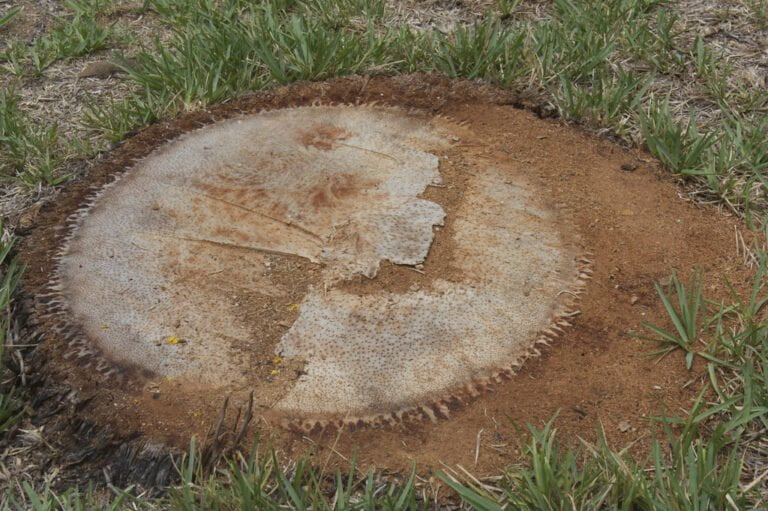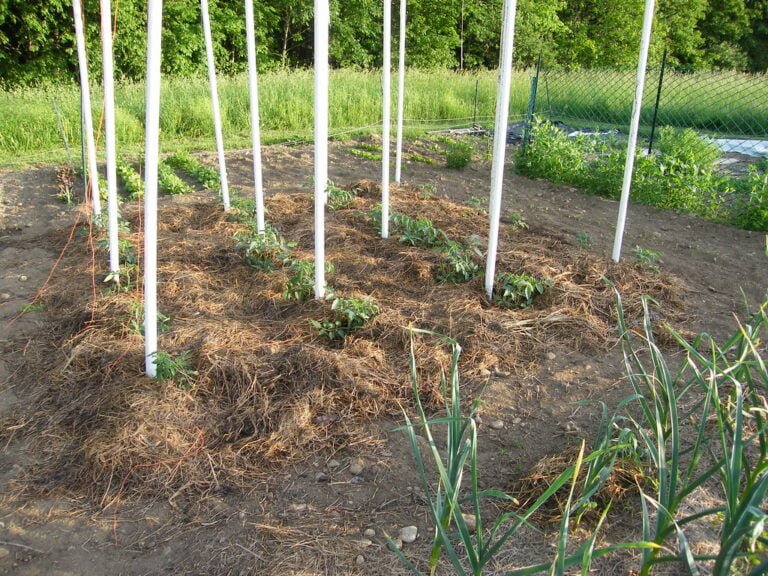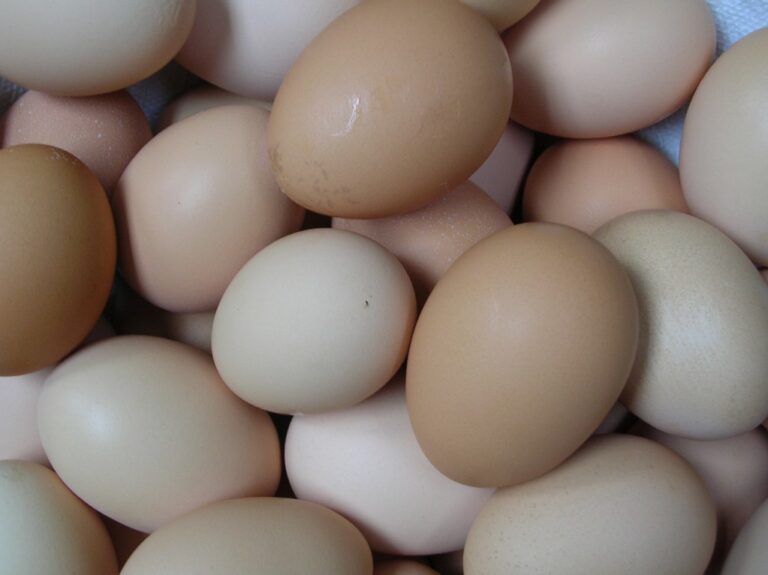Choosing the Right Fertilizer for Bell Peppers
When fertilizing bell peppers, make sure the N-P-K ratio suits their needs. Opt for a balanced ratio like 5-10-10. Look for fertilizers containing calcium, magnesium, to support growth. Choose formulations for vegetables or peppers for best results. Check soil tests for deficiencies to guide fertilizer selection. Focus on phosphorus for fruit and flower development. Time nitrogen applications strategically throughout the growth stages. Put nutrients in place to aid fruit production. For more tips on maximizing bell pepper growth and yield, investigate further resources.
Importance of Soil Testing
Soil testing is an important practice that I conduct annually before planting bell peppers to accurately assess the existing nutrient levels in the soil. This process is essential as it helps me identify any deficiencies or excess of nutrients that are important for ideal bell pepper growth. Through soil testing, I can also determine the pH levels, organic matter content, and overall nutrient availability in the soil. Understanding these factors guides me in selecting the right type of fertilizer and determining the appropriate application rates for achieving the best results in bell pepper production.
Nutrient Content Assessment
Evaluating the nutrient content of fertilizers is essential for determining the best balance of essential elements needed for strong bell pepper growth. When selecting fertilizers for bell peppers, it is important to evaluate the N-P-K ratio indicated on the packaging. For ideal growth, a recommended ratio of 5-10-10 is suitable, guaranteeing a sufficient supply of nitrogen for foliage development, phosphorus for energy absorption, and potassium for nutrient flow within the plant.
To meet the specific nutrient needs of bell peppers, consider conducting soil tests to identify deficiencies accurately. These tests provide valuable information for selecting fertilizers that not only contain the primary N-P-K elements but also micronutrients such as calcium and magnesium. Micronutrients play a critical role in addressing deficiencies that can hinder the growth and fruit production of bell pepper plants.
When applying fertilizers, ensure complete dissolution to facilitate optimal absorption by the bell pepper plants. This process promotes healthy growth, improves nutrient uptake, and ultimately boosts fruit production. By carefully evaluating the nutrient content of fertilizers and addressing the specific needs of bell peppers, you can create an ideal environment for robust plant development and a bountiful harvest.
Benefits of Adding Compost
Enriching the soil with organic compost offers bell peppers a multitude of benefits. Compost is a valuable source of organic matter, essential for improving soil structure and boosting water retention, which is important for the growth of bell peppers. Additionally, adding compost to the soil greatly enhances soil fertility by providing essential nutrients such as nitrogen, phosphorus, and potassium. These nutrients are essential for the healthy development of bell pepper plants, ensuring they receive the necessary components for robust growth and high-quality fruit production.
Furthermore, organic compost plays a key role in promoting microbial activity within the soil. This microbial community aids in the breakdown of organic matter, facilitating nutrient cycling and making these nutrients more accessible to the bell pepper plants. The improved microbial activity resulting from the addition of compost supports overall plant growth and health, contributing to improved yields and plant resilience.
Moreover, the use of compost can benefit bell peppers by helping to suppress diseases and pests naturally. The microorganisms present in compost can act as a form of biological control against harmful pathogens and pests, creating a more balanced and healthy environment for the plants to thrive. By reducing the reliance on synthetic fertilizers, incorporating compost into the soil promotes sustainable gardening practices, minimizing environmental impact and fostering long-term soil health for bell pepper cultivation.
Selection of Balanced Fertilizer
Shifting from the advantages of adding compost to bell peppers, choosing a well-rounded fertilizer with an appropriate N-P-K ratio is essential for maximizing the growth and productivity of bell pepper plants. When selecting a balanced fertilizer for bell peppers, consider the following points:
- Balanced Fertilizers: Opt for fertilizers with an N-P-K ratio of 5-10-10 as they provide essential nutrients like nitrogen, phosphorus, and potassium in the right proportions.
- Micronutrients: Choose fertilizers that also contain micronutrients such as calcium and magnesium. These micronutrients are vital for overall plant health and development.
- Leafy Growth and Flower Development: Balanced fertilizers support robust leafy growth and aid in the development of healthy flowers, which are important for fruit production in bell pepper plants.
- Specific Formulations: Select fertilizers specifically formulated for vegetables or peppers. These formulations ensure that bell pepper plants receive top-notch nutrition, promoting healthy growth and maximizing yield potential.
Consideration of Phosphorus Levels
Phosphorus plays a vital role in maximizing fruit production and flower development in bell pepper plants. Bell peppers have a higher demand for phosphorus to support their growth and yield. Adequate phosphorus levels are essential for the development of flowers and fruits in bell pepper plants. Conducting soil tests is crucial to determine the current levels of phosphorus present in the soil. This information helps in selecting the right fertilizer with a balanced N-P-K ratio, ensuring slightly higher phosphorus levels to meet the plant’s requirements.
When considering phosphorus levels for bell peppers, it is crucial to avoid over-fertilization. Excessive phosphorus can lead to nutrient imbalances in the soil, causing potential harm to the plants. Using a balanced fertilizer with the appropriate phosphorus content is key to promoting optimal fruit production and flower development in bell pepper plants. By carefully managing phosphorus levels and ensuring a balanced nutrient supply, growers can support the overall health and productivity of their bell pepper crops.
Significance of Nitrogen Application
Nitrogen plays a pivotal role in fostering robust foliage growth in bell pepper plants. Insufficient nitrogen levels can manifest in stunted growth and compromised plant health. Timely and balanced nitrogen application is critical for supporting efficient photosynthesis and maximizing bell pepper yield.
Nitrogen for Plant Growth
To promote robust growth and foliage development in bell pepper plants, ensuring an adequate supply of essential nutrients like nitrogen is essential. Here are key points on the significance of nitrogen for plant growth:
- Nitrogen is vital for photosynthesis and encouraging lush foliage growth in bell pepper plants.
- Sufficient nitrogen application at the right stages stimulates stem and leaf development, contributing to healthy plants.
- Nitrogen deficiency can lead to stunted growth, yellowing leaves, and reduced fruit production in bell peppers.
- Balancing nitrogen levels with other essential nutrients like phosphorus and potassium is crucial for overall plant health. Proper timing and dosage of nitrogen fertilizer application are necessary for the best growth and yield in bell pepper plants.
Nitrogen Deficiency Symptoms
Addressing the absence of nitrogen in bell pepper plants is essential for restoring ideal growth and fruiting. Nitrogen deficiency symptoms appear in bell peppers through pale yellow leaves, stunted growth, and reduced fruit production. This deficiency impedes chlorophyll production, impacting photosynthesis and overall plant development. To address this issue, timely nitrogen application is necessary to promote healthy foliage, robust stem growth, and overall plant vigor. By monitoring key indicators such as leaf color, plant size, and fruit quality, farmers can promptly identify and correct nitrogen deficiencies in bell pepper crops. Ensuring sufficient nitrogen levels through proper fertilization is paramount for sustaining ideal growth, maximizing yield, and enhancing the overall quality of bell pepper harvests.
Nitrogen Application Timing
Encouraging early growth and development in bell pepper plants, applying nitrogen before planting is essential for ensuring excellent yields and plant health. Proper timing of nitrogen application is vital to maximize fruit production and overall plant health. Here are key points to take into account:
- 30% Pre-Planting: Stimulates initial growth stages.
- 45% Two Weeks After Planting: Supports stem and foliage development.
- 25% End of Harvest: Maintains plant health for best fruit production.
- Balanced Application: Helps achieve a healthy equilibrium between vegetative growth and fruiting in bell pepper plants.
Timing for Optimal Fruit Production
When aiming for ideal fruit production in bell peppers, timing plays a pivotal role in ensuring nutrient availability aligns with the plant’s growth stages. Phosphorus application before planting is critical for promoting robust root development, which aids in early fruit formation. It sets the foundation for a strong root system that can support the plant throughout its growth cycle. Delaying fertilization post-transplantation is beneficial as it allows young bell pepper plants to establish their root systems before actively taking up nutrients. This strategy supports the plants in shifting smoothly and efficiently into the nutrient uptake phase, enhancing their overall health and productivity.
Nitrogen application before fruit set is essential for fostering healthy foliage growth, which in turn contributes to ideal fruit production in bell peppers. Ensuring an adequate nitrogen supply at this stage supports the plant in channeling its resources towards fruit development. Additionally, resuming fertilization after the initial harvest is crucial as it provides the necessary nutrients for sustained plant growth and ongoing fruit maturation. However, it is imperative to avoid over-fertilization, as it can negatively impact fruit quality and stress the plant. Monitoring nutrient levels and adjusting fertilization practices accordingly is key to maintaining plant health and maximizing fruit production in bell peppers.






